Learn how to make the best frittata with this foolproof recipe! I tested this recipe to find just the right ratio of eggs to cream for a texture that is firm and sliceable, but not watery or rubbery. By using the correct ratio, you’ll end up with an egg base that is creamy, while still being sturdy enough to slice and hold various additions. Flavor this one-pan egg bake any way you like by adding your preferred add-ins like vegetables, meats, marinated veggies, and different cheeses.
A reader, Lynn, says: “Absolutely the BEST frittata!!!! I used red bell pepper, potato, zucchini and sun-dried tomatoes! Fab combination! Just made and will freeze for a weekend of entertaining overnight guests! Freezes beautifully.” ★★★★★
Table of Contents
What Is A Frittata?
Put simply, a frittata is an Italian egg dish. It consists of a light custard made of eggs and a splash of heavy cream poured over aromatics and herbs, as well as other optional add-ins like vegetables and meats. A frittata is actually quite similar to an omelette, but instead of being folded, it’s cooked and then sliced. It’s typically cooked in cast-iron, either on the stovetop or in the oven (or both, like this recipe). While frittatas are a popular brunch dish, these egg bakes work very well for any meal of the day!
How is it different from a quiche? While both are egg-based breakfast dishes, there are a few key differences between a quiche and an egg frittata recipe: Quiche originated in France, has a flaky crust, and is baked in the oven. The ratios of eggs and dairy are also quite different. You can think of a frittata sort of like a crustless quiche!

My Secret To The Best Frittata
When developing this recipe, I wanted to find just the right combination of eggs and dairy to ensure the frittata was sliceable but not too firm or too soft. Some frittata recipes use milk, which I found made the eggs too watery when cooked. Others used less dairy in comparison to the number of eggs, which can make the eggs a bit rubbery once baked.
My perfect frittata recipe uses 8 eggs and ⅓ cup of heavy cream (not milk or half and half!). That’s a ratio of 2 teaspoons or 10ml of dairy per egg. I chose heavy cream because the added fat in the cream makes the proteins in the eggs set less firmly, yielding a more velvety, custard-like texture. Unlike milk, it doesn’t water down the eggs either, so they bake up creamy yet sturdy. No spongy frittatas here! You can use this ratio to scale your frittata up or down if you want to vary the serving amount.
Key Ingredients

These are the main ingredients you need to make this easy frittata recipe. You can find the full list of ingredients and measurements in the recipe card below.
Eggs — eggs are the star of the show and form the base of the frittata recipe. You’ll whisk it with heavy cream to make a creamy custard.
Heavy cream — a little heavy cream adds richness and contributes to the base’s velvety (never watery!) texture. As mentioned previously, it also affects how the proteins in the eggs set, so the frittata has a delicious texture that is creamy and not too firm.
Salt — a vital flavor-maker, salt is a must to season the eggs and veggies. It also contributes to fluffy eggs by breaking down their proteins!
Aromatics — cook onion and garlic in olive oil to give your frittata recipe the most mouthwatering aroma and foundation of savory flavor. This will flavor the base of the frittata and set the stage for any other additions you choose.
Mix-ins — you’ll need 5 cups of chunky additions to stuff your frittata with flavor. These can be things like chopped vegetables, leafy greens, or browned sausage. Plus, we’ll sprinkle in some cheese for gooeyness and flavor. I included plenty of ideas below for how to mix and match to flavor your frittata how you want!
Mix And Match These Add-Ins
One of my favorite things about an Italian frittata is how versatile it is. For the add-ins, I usually just throw in what’s lying around in my fridge— it’s a great way to use up odds and ends and give them new life! I will also mix and match ingredients depending on what my family or guests prefer. Here are some ideas for what you can add to jazz up your frittata recipe:
- Tender vegetables: Quick-cooking veggies like squash, zucchini, bell pepper, mushrooms, peas, leeks, green onions, broccoli, cauliflower, and asparagus are great options!
- Root vegetables: Pre-roast harder vegetables like potatoes, butternut squash, sweet potatoes, and carrots. Or, use leftovers! My roasted potatoes, roasted sweet potatoes, roasted carrots, or roasted butternut squash are all great in this recipe.
- Leafy greens: For even more color, throw in leafy greens like kale, spinach, Swiss chard, or peppery arugula. Chop any larger greens into bite-sized pieces before adding them to the skillet.
- Preserved vegetables: Add a tangy element with marinated artichoke hearts, pitted olives, roasted red peppers, or sun-dried tomatoes. Since these are stronger in flavor, I recommend using 1 cup or less of your total 3 cups of added vegetables.
- Cheeses: You can use basically any cheese you’d like! Your favorite shredded cheese, crumbled goat cheese, or feta cheese all work so well! Shredded cheese adds to the creaminess of the egg custard, while goat or feta cheese adds tang and a bit more texture.
- Meats: Diced ham, crumbled bacon (cooked), browned sausage, and even cooked shredded chicken all taste wonderful in this frittata recipe. Replace 1 to 2 cups of veggies or greens with a cooked protein.
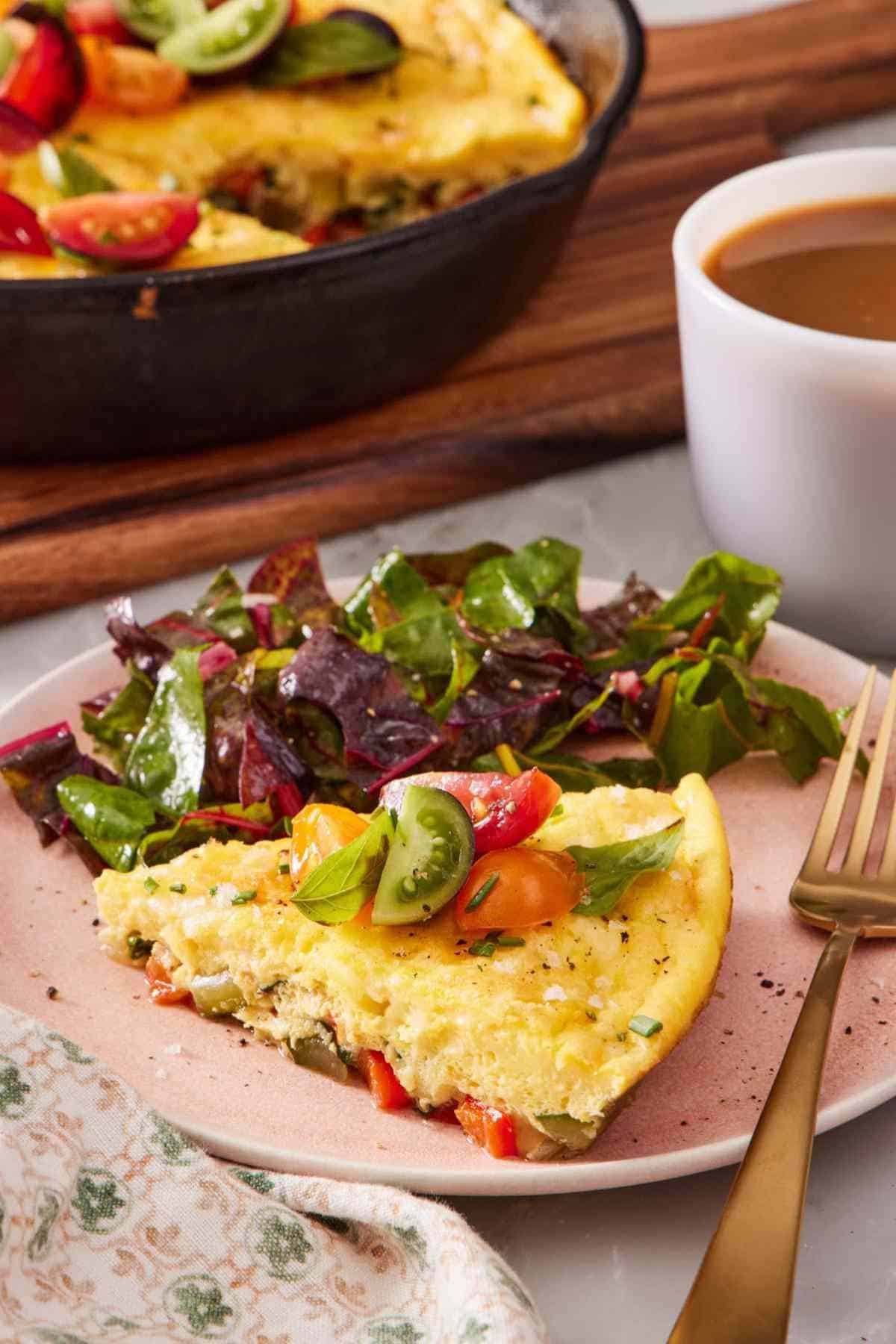
Can This Be Prepped Ahead Of Time?
The different elements of this frittata recipe can be prepared ahead of time. Cook the veggies and whisk up the custard base, then store each separately in the refrigerator. When ready, reheat the veggies in the skillet, whisk the egg mixture once more, and pour it on top. Cook as directed. For the best results, I recommend assembling and baking the frittata when you want to serve it. However, the baked frittata does keep well in the fridge for a few days if you want to prep a make-ahead breakfast.
Pro Tips For Making The Best Frittata
Choose your pan size. You can use either a 10-inch skillet or a 12-inch skillet for this frittata recipe. For a thicker frittata, use a 10-inch cast-iron pan and add a couple of minutes onto the bake time.
Always pre-cook vegetables before adding the egg mixture. Raw vegetables will release extra moisture to the dish, and you’ll end up with a soggy frittata.
Avoid over beating the eggs. Doing so will incorporate too much air into the mixture. Once in the oven, it’ll cause the frittata to puff up excessively and yield a frittata that’s dry with a spongy texture. Whisk the egg mixture just until the eggs are well combined with the cream, not frothy or increasing in volume.
How to tell when the frittata is done baking: You can test it by inserting the tip of a knife into the center of the frittata; if it comes out clean, it’s done.
How To Make A Frittata
Below, I’ve highlighted portions of the recipe in step-by-step process images along with instructions for making a frittata. You can find the full set of instructions in the recipe card below.
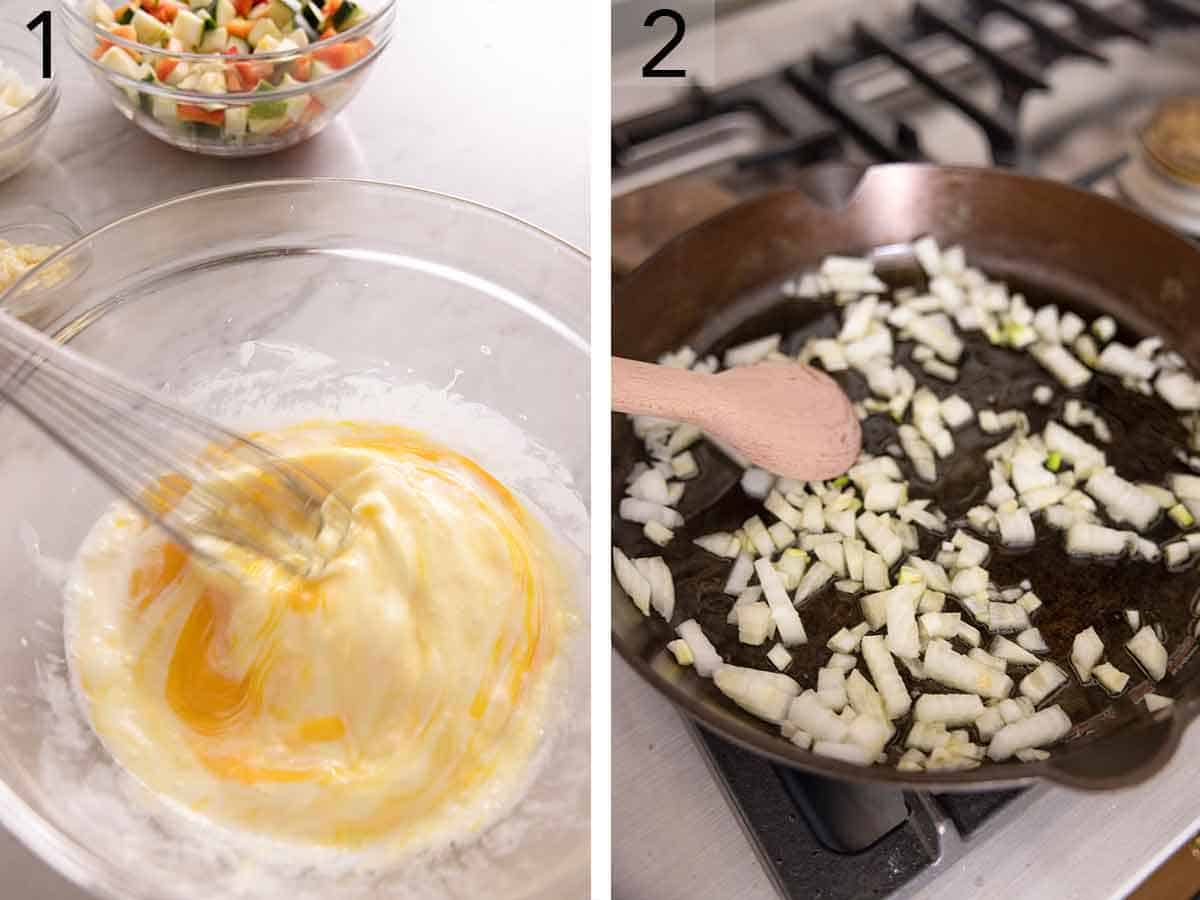
1. Whisk together the eggs, cream, and ½ teaspoon salt in a large bowl. Don’t over-mix: Just whisk until they’re combined. You don’t want too much air getting into the eggs.
2. Heat the olive oil over medium heat in an oven-safe skillet (like a cast-iron skillet) before adding chopped onion and salt. Cook for about 5 minutes, until the onions start turning translucent, then stir in the garlic and cook until fragrant.

3. Add your prepared vegetables to the skillet and cook until crisp-tender.
4. Throw in leafy greens and season with black pepper, then cook until the greens are wilted.
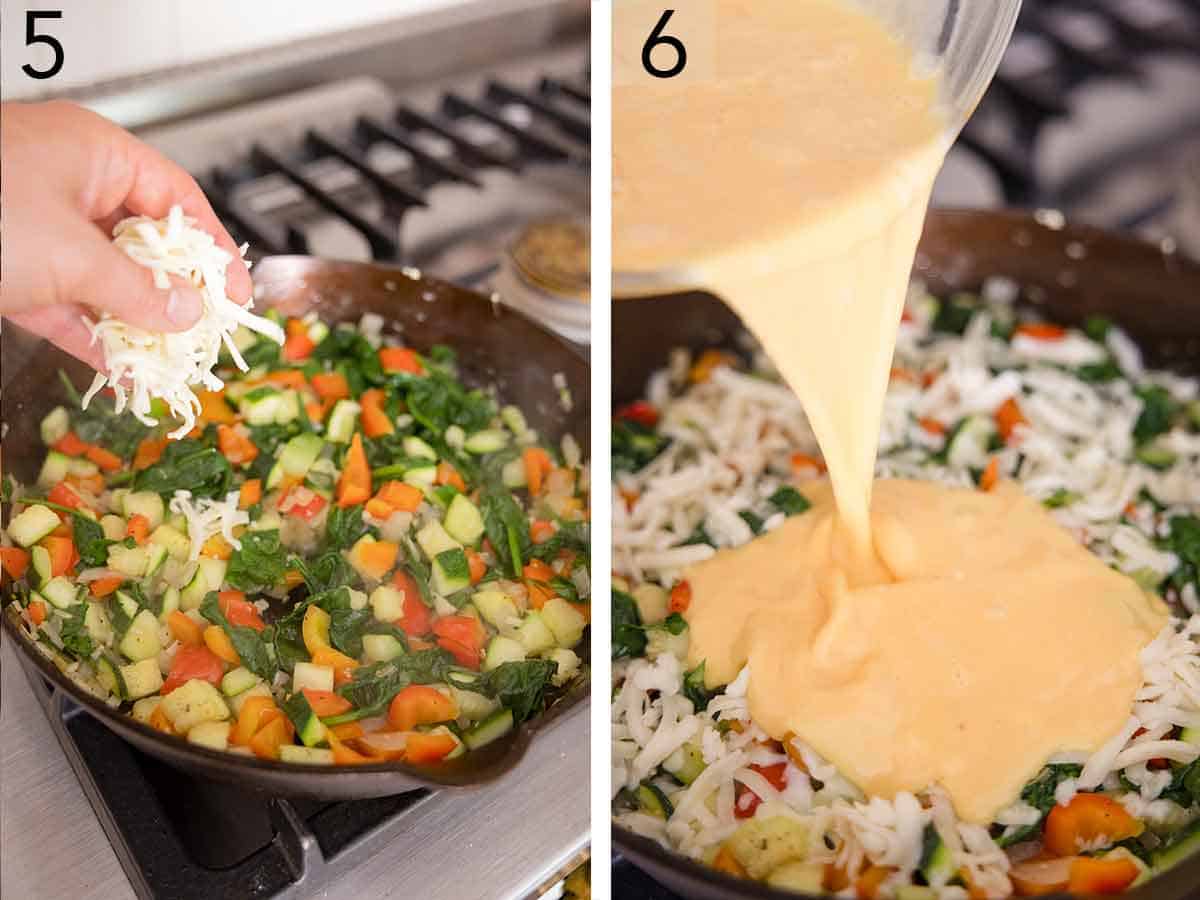
5. Spread the vegetables into an even layer in the bottom of the skillet and sprinkle 1 cup of cheese over the top.
6. Pour the egg mixture over the cooked vegetables and cheese. The best way to distribute the egg custard evenly throughout the pan is to gently tilt and swirl the pan. Sprinkle the remaining cheese on top, and continue cooking for only about 5 minutes, until you see the edges start to set. Carefully (carefully!!) transfer the skillet to the oven. Use good oven mitts and take your time — the egg mixture will still be very watery and can slosh up the sides. Bake the frittata at 400°F for 8 to 12 minutes (exact cooking time will depend on your oven as well as the size of the skillet you chose). Allow it to cool for a few minutes before slicing and digging in.
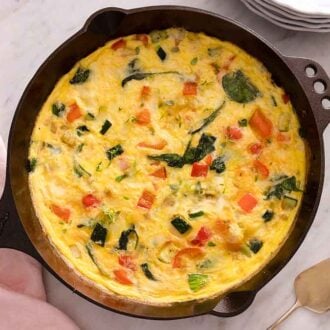
Frittata Recipe
Video
Equipment
- 10- or 12-inch skillet
Ingredients
Frittata Base:
- 8 large eggs
- ⅓ cup heavy cream (80mL)
- 1 teaspoon salt divided
- 3 tablespoons olive oil
- ½ cup chopped onion
- 4 garlic cloves minced
Add-ins:
- 3 cups chopped or sliced vegetables (such as bell pepper, potatoes, zucchini)
- 2 cups chopped leafy greens (such as kale or spinach)
- ½ teaspoon ground black pepper
- 1½ cups shredded or crumbled cheese (6 ounces)
- Chopped fresh herbs for serving (optional)
Instructions
- Preheat the oven to 400°F.
Make the Base:
- In a large bowl, whisk together the eggs, cream, and ½ teaspoon salt. Set aside.
- In a 10- or 12-inch cast-iron skillet, heat the olive oil over medium heat. Add the onion and remaining ½ teaspoon salt. Cook, stirring frequently, until the onions start to turn translucent, about 5 minutes.
- Stir in the garlic and cook for 1 minute.
Cook the Add-ins:
- Add any other chopped vegetables you choose to the skillet. Cook, stirring occasionally, until the veggies are crisp tender, about 5 to 8 minutes (depending on the vegetables you are using).
- Stir in the leafy greens and black pepper. Cook for 1 to 2 minutes, just until the greens are wilted.
- Spread the vegetables evenly over the bottom of the skillet. (Drizzle in another tablespoon of oil if the pan looks dry or the veggies are sticking.) Sprinkle 1 cup cheese over the vegetables.
Assemble and Bake:
- Pour the egg mixture over the cooked vegetables. Tilt and swirl the pan to evenly distribute egg mixture if needed. Sprinkle with remaining ½ cup cheese. Cook until just until the edge starts to set, about 5 minutes. Transfer the skillet to the oven.
- Bake for 8 to 12 minutes or until slightly puffed and the center is set. (A knife inserted into the center should come out clean.) Sprinkle with extra cheese and garnish with pepper and herbs if desired. Cool for a few minutes before slicing and serving.
Notes
- If you don’t have an oven-safe skillet like a cast iron, you can transfer the sautéed vegetables to a greased casserole dish and top with the cheese and egg mixture. Bake until the eggs have set.
- I love topping a slice of frittata with sour cream and additional chopped herbs! You can also add other veggies like sliced cherry tomatoes, diced avocado, or some lightly dressed salad greens when serving.
Nutrition
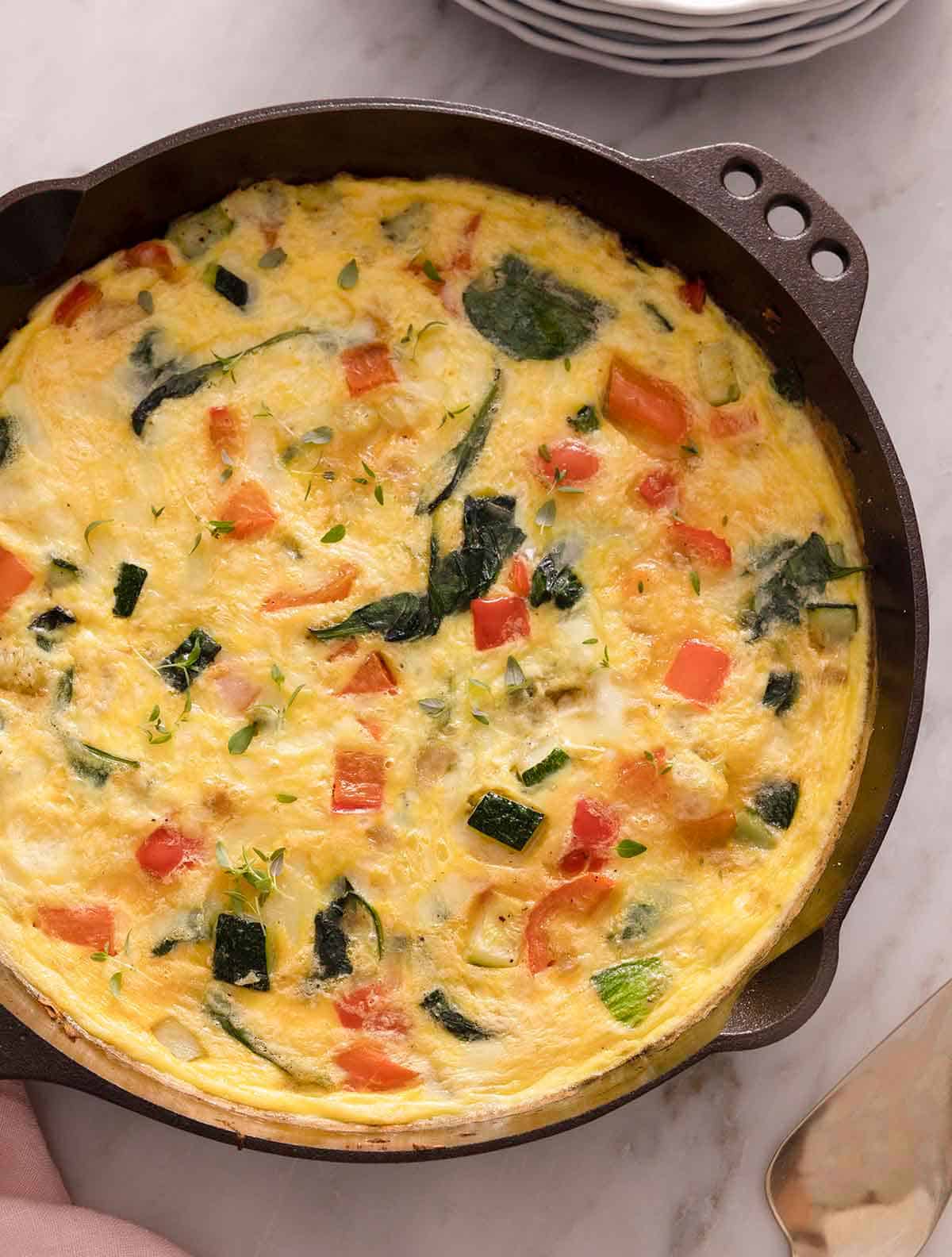
How To Store & Reheat Leftovers
Storing: Once completely cooled to room temperature, transfer leftover frittata to an airtight container and refrigerate for up to 5 days.
Freezing: You can freeze slices for up to 3 months. Wrap them in plastic wrap and store in a freezer bag. Thaw the frittata overnight in the refrigerator before reheating.
Reheating: To reheat, pop the frittata into the oven at 350°F for about 10 minutes. You can use the microwave for a quicker option, but it can make the eggs rubbery, so do this minimally, 30 to 45 seconds.
What To Serve With A Frittata
There are so many great options for what to serve with this frittata recipe! My personal favorites are candied bacon and air fryer bacon — a fun twist on a classic bacon and eggs breakfast. Homemade biscuits, sliced sourdough bread, or carrot muffins also work well, adding a bit more bulk. For a more refreshing addition, serve frittata with a colorful fruit salad.

More Breakfast Recipes To Try
Try these classic breakfast recipes next!
A twist on iconic French toast, my French toast sticks are a quick and easy breakfast recipe your whole family will love. You can freeze them to enjoy later!
It’s easy to make waffles from scratch. The batter stirs together quickly and yields fluffy, thick waffles, perfect for drenching with maple syrup!
My cheesy breakfast casserole has it all: Eggs, hashbrowns, veggies, and meat! Super convenient for feeding a small crowd.
Fluffy pancakes are a breeze to throw together with simple pantry ingredients. I love serving them with powdered sugar, a pat of butter, and a good glug of maple syrup.
Moist, tender blueberry muffins burst with flavor from plump berries. Bake them plain, or add a buttery streusel topping for some crunch.
If you’ve tried this frittata recipe, then don’t forget to rate it and let me know how you got on in the comments below. I love hearing from you!



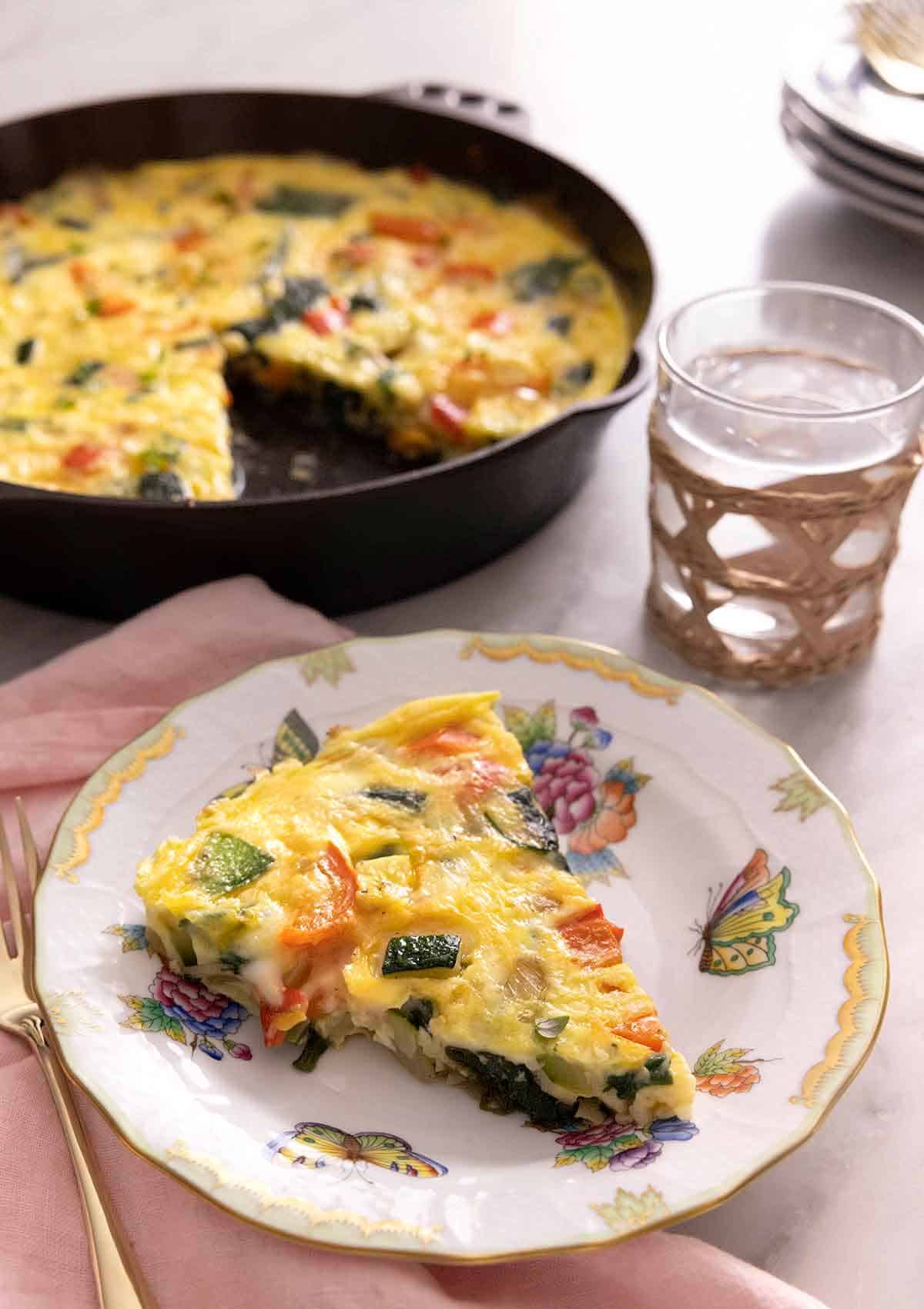
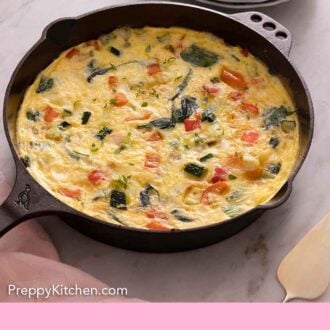
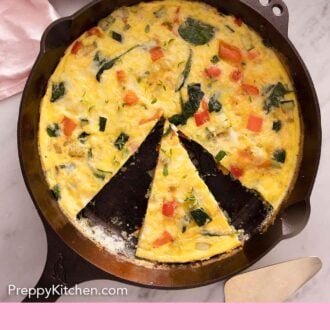

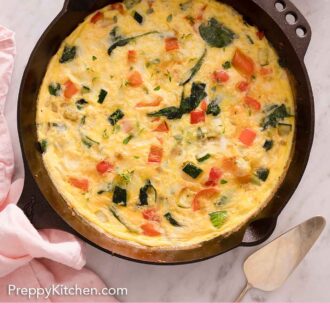
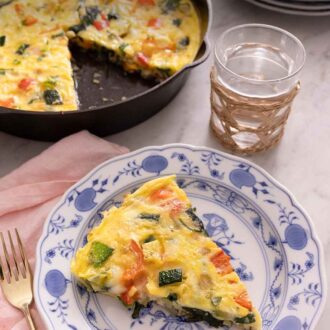
Lynne says
Absolutely the BEST frittata!!!! I used red bell pepper, potato, zucchini and sun-dried tomatoes! Fab combination! Just made and will freeze for a weekend of entertaining overnight guests! Freezes beautifully…. Thanks John!